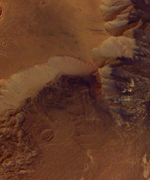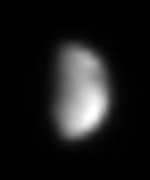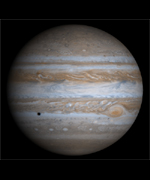In case you weren’t one of the 10,000 plus people who made the trip to Mojave airport to watch Monday’s launch of SpaceShipOne, here’s a photo gallery of images from that amazing day. A special thanks to correspondent and photographer Tony Hesch for taking these amazing photos from the event. And a big thanks to Scaled Composites for giving Universe Today backstage access to all the action. I really wish I could have made the trip myself… maybe next time. 🙂
Russia Cancels Olsen’s Trip to Space
Although he was scheduled to become the third privately funded person to fly to the International Space Station, Gregory Olsen appears to have had his wings clipped. Officials from the Russian Space Agency said today that Olsen has been dropped from the program because of health concerns. This is unusual, because Olsen has already been training at Moscow’s Star City for several months, and has already undergone many health tests. Olsen, the founder of Sensors Unlimited in New Jersey had been planning to perform some experiments while on board the station.
Deeper Analysis of Phoebe Flyby
Like a woolly mammoth trapped in Arctic ice, Saturn’s small moon Phoebe may be a frozen artifact of a bygone era, some four billion years ago. The finding is suggested by new data from the Cassini spacecraft.
Cassini scientists reviewed data from the spacecraft’s June 11, 2004, flyby of the diminutive moon. They concluded Phoebe is likely a primordial mixture of ice, rock and carbon-containing compounds similar in many ways to material seen in Pluto and Neptune’s moon Triton. Scientists believe bodies like Phoebe were plentiful in the outer reaches of the solar system about four and a half billion years ago.
These icy planetesimals (small bodies) formed the building blocks of the outer solar system and some were incorporated into the giant planets Jupiter, Saturn, Uranus and Neptune. During this process, gravitational interactions ejected much of this material to distant orbits, joining a native population of similar bodies to form the Kuiper Belt.
“Phoebe apparently stayed behind, trapped in orbit about the young Saturn, waiting eons for its secrets to be revealed during its rendezvous with the Cassini spacecraft,” said Dr. Torrence Johnson, Cassini imaging team member at NASA’s Jet Propulsion Laboratory, Pasadena, Calif.
“All our evidence leads us to conclude, Phoebe’s surface is made of water ice, water-bearing minerals, carbon dioxide, possible clays and primitive organic chemicals in patches at different locations on the surface,” said Dr. Roger N. Clark, team member for the visual and infrared mapping spectrometer, U.S. Geological Survey in Denver. “We also see spectral signatures of materials we have not yet identified.” Cassini’s observations gave scientists the first detailed look at one of these primitive icy planetesimals.
Phoebe’s mass was determined from precise tracking of the spacecraft and optical navigation, combined with an accurate volume estimate from images. The measurements yield a density of about 1.6 grams per cubic centimeter (100 pounds per cubic foot), much lighter than most rocks, but heavier than pure ice at approximately 0.93 grams per cubic centimeter (58 pounds per cubic foot). This suggests a composition of ice and rock similar to Pluto and Triton.
Spectral measurements, light intensity as a function of color or wavelength, confirmed the presence of water ice previously detected by Earth-based telescopes. The measurements provided evidence for hydrated minerals on Phoebe’s surface, and detected carbon dioxide and solid hydrocarbons similar to those found in primitive meteorites.
“One intriguing result is the discovery of possible chemical similarities between the materials on Phoebe and those seen on comets,” said Dr. Robert H. Brown, team leader for the visible and infrared mapping spectrometer, University of Arizona, Tucson. Evidence that Phoebe might be chemically kin to comets strengthens the case that it is similar to Kuiper Belt Objects.
Measurements taken by the composite infrared spectrometer were used to generate temperature maps. The maps show the surface of Phoebe is very cold, only about 110 degrees above absolute zero (minus 163 degrees Celsius, or minus 261 degrees Fahrenheit). Even colder nighttime temperatures suggest a fluffy, porous surface layer.
“One of the first results from this map is the surface of Phoebe has been badly chewed up, probably by meteorite impacts,” said Dr. John Pearl, a Cassini co-investigator for the composite infrared spectrometer, at NASA’s Goddard Space Flight Center, Greenbelt, Md. “We are discovering Phoebe is a very complex object, with large variations in topography.”
Cassini also made radar observations of Phoebe’s enigmatic surface, making it the first spacecraft radar observations of an outer-planet moon. The results are consistent with the dirty, rocky, icy surface suggested by other observations.
“We have conducted our first analysis of an outer solar system resident akin to Kuiper Belt Objects,” said Dr. Dennis Matson, project scientist of the Cassini-Huygens mission at JPL. “In two short weeks, we have added more to what we know about Phoebe than we had learned about it since it was discovered 100 years ago. We did this by having multiple instruments conducting investigations all at one time during our flyby.”
The Cassini-Huygens mission is a cooperative project of NASA, the European Space Agency and the Italian Space Agency. JPL manages the mission for NASA’s Office of Space Science, Washington. For the latest images and more information about the mission on the Internet, visit http://www.nasa.gov and http://saturn.jpl.nasa.gov .
Original Source: NASA/JPL News Release
Space Simulator Models the Universe
For the past several years, a team of University of California astrophysicists working at Los Alamos National Laboratory have been using a cluster of roughly 300 computer processors to model some of the most intriguing aspects of the Universe. Called the Space Simulator, this de facto supercomputer has not only proven itself to be one of the fastest supercomputers in the world, but has also demonstrated that modeling and simulation of complex phenomena, from supernovae to cosmology, can be done on a fairly economical basis.
According to Michael Warren, one of the Space Simulator’s three principal developers, “Our goal was to acquire a computer which would deliver the highest performance possible on the astrophysics simulations we wanted to run, while remaining within the modest budget that we were allotted. Building the Space Simulator turned out to be a excellent choice.”
The Space Simulator is a 294-node Beowulf cluster with theoretical peak performance just below 1.5 teraflops, or trillions of floating point operations per second. Each Space Simulator processing node looks much like a computer you would find at home than at a supercomputer center, consisting of a Pentium 4 processor, 1 gigabyte of 333 MHz SDRAM, an 80 gigabyte hard drive and a gigabit
Ethernet card. Each individual node cost less than $1,000 and the entire system cost under $500,000. The cluster achieved Linpack performance of 665.1 gigaflops per second on 288 processors in October 2002, making it the 85th fastest computer in the world, according to the 20th TOP500 list (see www.top500.org). A gigaflop is a billion floating-point operations per second.
Since 2002, the Space Simulator has moved down to #344 on the most recent TOP500 list as faster computers are built, but Warren and his colleagues are not worried. They built the Space Simulator to do specific astrophysics research, not to compete with other computers. It was never designed to compete with Laboratory’s massive supercomputers and, in fact, is not scalable enough to do so.
The Space Simulator has been used almost continuously for theoretical astrophysics simulations since it was built, and has spent much of the past year calculating the evolution of the Universe. The first results of that work were recently presented at a research conference in Italy by Los Alamos postdoctoral research associate Luis Teodoro. Further analysis of the simulations, in collaboration with Princeton University professor Uros Seljak, will soon be published in the prestigious journal Monthly Notices of the Royal Astronomical Society. In addition to simulating the structure and evolution of the Universe, the Space Simulator has been used to study the explosions of massive stars and to help understand the X-ray emission from the center of our galaxy.
The Space Simulator is actually the Laboratory’s third generation Beowulf cluster. The first was Loki, which was constructed in 1996 from 16 200 MHz Pentium Pro processors. Loki was followed by the Avalon cluster, which consisted of 144 alpha processors. The Space Simulator follows the same basic architecture as these previous Beowulf machines, but is the first to use Gigabit Ethernet as the network fabric, and requires significantly less space than a cluster using typical computers. The Space Simulator runs parallel N-body algorithms, which were originally designed for astrophysical applications involving gravitational interactions, but have since been used to model more complex particle systems.
In addition to Warren, the developers of the Space Simulator include Los Alamos staff members Chris Fryer and Patrick Goda.
Los Alamos’ Laboratory-Directed Research and Development (LDRD) program provided funding for the Space Simulator research. LDRD funds basic and applied research and development focusing on employee-initiated creative proposals selected at the discretion of the Laboratory director.
Los Alamos National Laboratory is operated by the University of California for the National Nuclear Security Administration (NNSA) of the U.S. Department of Energy and works in partnership with NNSA’s Sandia and Lawrence Livermore national laboratories to support NNSA in its mission.
Los Alamos enhances global security by ensuring the safety and reliability of the U.S. nuclear deterrent, developing technologies to reduce threats from weapons of mass destruction, and solving problems related to defense, energy, environment, infrastructure, health and national security concerns.
Original Source: LANL News Release
General Accounting Office Blasts NASA
Science Committee Chairman Sherwood Boehlert (R-NY) and Ranking Minority Member Bart Gordon (D-TN) today released a General Accounting Office (GAO) study they had requested titled, ?NASA: Lack of Disciplined Cost-Estimating Processes Hinders Effective Program Management.?
GAO concluded that ?NASA lacks a clear understanding of how much programs will cost and how long they will take to achieve their objectives?.NASA?s basic cost-estimating processes?lack the discipline needed to ensure that program estimates are reasonable.? As part of the study, GAO reviewed 27 programs, 10 of them in-depth.
In a response included in the appendix to the GAO report, NASA ?concur[red]? with the recommendations in the report and listed steps the agency has underway to implement them. The recommendations include having NASA develop ?an integrated plan for improving cost estimating? and establishing ?a standard framework for developing life-cycle cost estimates.? The GAO report elaborates on those recommendations in some detail.
Boehlert said, ?This is something that started out as a ?bad news? story that appears to be heading for a happy ending. The report lays out in detail the problems that have repeatedly plagued NASA?s cost estimating over many years. Congress needs to be aware of these problems when evaluating NASA?s proposals. But NASA does have concrete steps underway to improve the situation, for which Administrator O?Keefe should be congratulated. GAO has told us that those steps will go a long way toward solving the problem. And there?s some indication that those steps are beginning to bear fruit. The newest program that GAO examined, the cockpit avionics upgrade, also was the one with the best performance, although GAO still had some concerns with it. So there?s cause for optimism. Our Committee?s job will be to ensure that NASA continues to implement the steps it has outlined fully, carefully and as speedily as possible.?
?The GAO report?s findings, when coupled with NASA?s failure to pass an independent financial audit for the past three years running, suggest that NASA needs to get its financial house in order,? Gordon said.
Original Source: House Committee on Science News Release
Wallpaper: The Valles Marineris Canyon

Image credit: ESA
On 2 May 2004, the High-Resolution Stereo Camera (HRSC) on board the ESA Mars Express spacecraft obtained images from the central area of the Mars canyon called Valles Marineris.
The images were taken at a resolution of approximately 16 metres per pixel. The displayed region is located at the southern rim of the Melas Chasma at Mars latitude 12?S and Mars longitude 285?E. The images were taken on orbit 360 of Mars Express.
This region shows several clues to the morphological and geological development of the Valles Marineris. The images show many traces of volcanic activity and possibly water-related acitivity. However, a lot of the surface has been altered by subsequent geological processes, such as wind erosion and quakes.
Although many questions about the geological development of the Valles Marineris canyon have remained unanswered until now, the detailed HRSC image data may help to find some answers. Using HRSC data, scientists can focus on morphology – the evolution of rocks and land forms. They can also analyse the light relected by the canyon to understand which type of rocks it is made out of.
Original Source: ESA News Release
Cassini’s First View of Iapetus

Image credit: NASA/JPL/Space Science Institute
This Cassini image hints at the split personality of Saturn?s 1436 kilometer (892 mile)-wide moon Iapetus. The Voyager spacecraft first imaged this curious yin/yang moon, with its light and dark hemispheres. The dark hemisphere is the side of Iapetus that leads in its orbit. In this view, both light and dark areas are visible.
The image was taken in visible light with the narrow angle camera on May 23, 2004, from a distance of 20.2 million kilometers (12.5 million miles) from Iapetus. The image scale is 12 kilometers (75 miles) per pixel. The image was magnified to aid visibility.
The Cassini-Huygens mission is a cooperative project of NASA, the European Space Agency and the Italian Space Agency. The Jet Propulsion Laboratory, a division of the California Institute of Technology in Pasadena, manages the Cassini-Huygens mission for NASA’s Office of Space Science, Washington, D.C. The imaging team is based at the Space Science Institute, Boulder, Colorado.
For more information about the Cassini-Huygens mission, visit http://saturn.jpl.nasa.gov and the Cassini imaging team home page, http://ciclops.org.
TV Alert: “The Dark Side of the Universe”
Scientific American Frontiers, one of my favorite TV shows, is going to be looking into the mysteries of Dark Matter and Dark Energy on Tuesday on PBS, so if you’re around a television, I highly recommend you set aside some time to watch. It’s called “The Dark Side of the Universe“. As usual, it’s hosted by Alan Alda, who traveled to Chile to talk to astronomers working on the latest research. You’ll have to check your local show times, but it’s airing on Tuesday, June 22 from 8-9 pm on my local PBS station, which broadcasts out of Seattle. For those of you who can’t get PBS, I’m pretty sure the entire show is going to be available on the web a few days after it airs on TV.
Enjoy!
Fraser Cain
Publisher
Universe Today
Earth’s Oceans are Banded Like Jupiter’s Clouds

Image credit: NASA/JPL
In a study published in Geophysical Research Letters (Vol. 31, No.13), University of South Florida College of Marine Science professor Boris Galperin explained a link between the movement and appearance of ocean currents on Earth and the bands that characterize the surface of Jupiter and some other giant planets.
“The banded structure of Jupiter has long been a subject of fascination and intensive research,”said Galperin, a physical oceanographer who analyzes turbulence theory and applies theory and numerical modeling to analyze planetary processes. “The visible bands on Jupiter are formed by clouds moving along a stable set of alternating flows.”
Galperin and colleagues have discovered that the oceans on Earth also harbor stable alternating bands of current that, when modeled, reveal a striking similarity to the bands on Jupiter due to the same kinds of “jets.”
“We think this resemblance is more than just visual,” he said. “The energy spectrum of the oceanic jets obeys a power law that fits the spectra of zonal flows on the outer planets.”
The observation begs the question of whether the similar phenomena are rooted in similar physical forces.
“To answer this question,” said Galperin, “one needs to determine what physical processes govern the large-scale dynamics in both systems.”
According to Galperin, there is a similarity in the forcing agents for planetary and oceanic circulations. The study maintains that both sets of zonal jets – the ocean’s bands of currents and the bands of Jupiter’s clouds – are the result of an underlying turbulent flow regime common in nature.
Comparing the energy spectra on giant planets and in the Earth’s oceans can yield valuable information about the transport properties of the oceans, said Galperin, especially about the strongest currents in the mid-depth ocean.
“The implications of these findings for climate research on Earth and the designs of future outer space observational studies are important,” he explained.
Galperin (http://www.marine.usf.edu/phy/galperin.html) and colleagues Hideyuki Nakano, Meteorological Research Institute, Ibaraki, Japan; Huei-Ping Huang, Lamont-Dougherty Earth Observatory of Columbia University, Palisades, New York; and Semion Sukoriansky, Center for Aeronautical Engineering Studies, Ben Gurion University of the Negev, Beer-Sheva, Israel, reported their research at the 25th Conference of the International Union of Geodesy and Geophysics’s Committee on Mathematical Geophysics, held June 16-18 at Columbia University.
Funding for the study came from the Army Research Office and the Israel Science Foundation.
Original Source: USF News Release
New Molecules Discovered in Interstellar Space

Image credit: NRAO
A team of scientists using the National Science Foundation’s Robert C. Byrd Green Bank Telescope (GBT) has discovered two new molecules in an interstellar cloud near the center of the Milky Way Galaxy. This discovery is the GBT’s first detection of new molecules, and is already helping astronomers better understand the complex processes by which large molecules form in space.
The 8-atom molecule propenal and the 10-atom molecule propanal were detected in a large cloud of gas and dust some 26,000 light-years away in an area known as Sagittarius B2. Such clouds, often many light-years across, are the raw material from which new stars are formed.
“Though very rarefied by Earth standards, these interstellar clouds are the sites of complex chemical reactions that occur over hundreds-of-thousands or millions of years,” said Jan M. Hollis of the NASA Goddard Space Flight Center in Greenbelt, Md. “Over time, more and more complex molecules can be formed in these clouds. At present, however, there is no accepted theory addressing how interstellar molecules containing more than 5 atoms are formed.”
So far, about 130 different molecules have been discovered in interstellar clouds. Most of these molecules contain a small number of atoms, and only a few molecules with eight or more atoms have been found in interstellar clouds. Each time a new molecule is discovered, it helps to constrain the formation chemistry and the nature of interstellar dust grains, which are believed to be the formation sites of most complex interstellar molecules.
Hollis collaborated with Anthony Remijan, also of NASA Goddard; Frank J. Lovas of the National Institute of Standards and Technology in Gaithersburg, Md.; Harald Mollendal of the University of Oslo, Norway; and Philip R. Jewell of the National Radio Astronomy Observatory (NRAO) in Green Bank, W.Va. Their results were accepted for publication in the Astrophysical Journal Letters.
In the GBT experiment, three aldehyde molecules were observed and appear to be related by simple hydrogen addition reactions, which probably occur on the surface of interstellar grains. An aldehyde is a molecule that contains the aldehyde group (CHO): a carbon atom singly bonded to a hydrogen atom and double-bonded to an oxygen atom; the remaining bond on that same carbon atom bonds to the rest of the molecule.
Starting with previously reported propynal (HC2CHO), propenal (CH2CHCHO) is formed by adding two hydrogen atoms. By the same process propanal (CH3CH2CHO) is formed from propenal.
After these molecules are formed on interstellar dust grains, they may be ejected as a diffuse gas. If enough molecules accumulate in the gas, they can be detected with a radio telescope. As the molecules rotate end-for-end, they change from one rotational energy state to another, emitting radio waves at precise frequencies. The “family” of radio frequencies emitted by a particular molecule forms a unique “fingerprint” that scientists can use to identify that molecule. The scientists identified the two new aldehydes by detecting a number of frequencies of radio emission in what is termed the K-band region (18 to 26 GHz) of the electromagnetic spectrum.
“Interstellar molecules are identified by means of the frequencies that are unique to the rotational spectrum of each molecule,” said Lovas. “These are either directly measured in the laboratory or calculated from the measured data. In this case we used the calculated spectral frequencies based on an analysis of the literature data.”
Complex molecules in space are of interest for many reasons, including their possible connection to the formation of biologically significant molecules on the early Earth. Complex molecules might have formed on the early Earth, or they might have first formed in interstellar clouds and been transported to the surface of the Earth.
Molecules with the aldehyde group are particularly interesting since several biologically significant molecules, including a family of sugar molecules, are aldehydes.
“The GBT can be used to fully explore the possibility that a significant amount of prebiotic chemistry may occur in space long before it occurs on a newly formed planet,” said Remijan. “Comets form from interstellar clouds and incessantly bombard a newly formed planet early in its history. Craters on our Moon attest to this. Thus, comets may be the delivery vehicles for organic molecules necessary for life to begin on a new planet.”
Laboratory experiments also demonstrate that atomic addition reactions — similar to those assumed to occur in interstellar clouds — play a role in synthesizing complex molecules by subjecting ices containing simpler molecules such as water, carbon dioxide, and methanol to ionizing radiation dosages. Thus, laboratory experiments can now be devised with various ice components to attempt production of the aldehydes observed with the GBT.
“The detection of the two new aldehydes, which are related by a common chemical pathway called hydrogen addition, demonstrates that evolution to more complex species occurs routinely in interstellar clouds and that a relatively simple mechanism may build large molecules out of smaller ones. The GBT is now a key instrument in exploring chemical evolution in space,” said Hollis.
The GBT is the world’s largest fully steerable radio telescope; it is operated by the NRAO.
“The large diameter and high precision of the GBT allowed us to study small interstellar clouds that can absorb the radiation from a bright, background source. The sensitivity and flexibility of the telescope gave us an important new tool for the study of complex interstellar molecules,” said Jewell.
The National Radio Astronomy Observatory is a facility of the National Science Foundation, operated under cooperative agreement by Associated Universities, Inc.
Original Source: NRAO News Release
